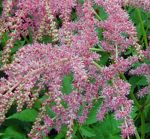 Thungbergs’s astilbe is a herbaceous perennial native to East Asia. It is a member of the saxifrage family, Saxifracaceae, that also includes Bergenia, foamflower (Tiarella), and coral bells (Heuchera). The rhizomatceous plants form broad clumps of basal foliage with ten to twelve inch long, oval to lance-shaped, 2-ternate leaves. In mid- to late summer arching, loosely-branched drooping panicles of white or pink flowers appear above the foliage and are followed by attractive seedheads that persist into fall. Plants grow best in moist partial shaded areas but can be grown in full sun where temperatures are cool and the soil in consistently moist. They are a good choice for a shade or woodland garden and do well in containers. The generic name Astilbe comes from the Greek words a meaning without and stilbe meaning brightness referring to the dull leaves of some species. The specific epithet Thunbergii comes from the last name of a Swedish botanist and friend of Linnaeus who traveled as a doctor with the Dutch East India company and sent plants from Japan to Europe.
Thungbergs’s astilbe is a herbaceous perennial native to East Asia. It is a member of the saxifrage family, Saxifracaceae, that also includes Bergenia, foamflower (Tiarella), and coral bells (Heuchera). The rhizomatceous plants form broad clumps of basal foliage with ten to twelve inch long, oval to lance-shaped, 2-ternate leaves. In mid- to late summer arching, loosely-branched drooping panicles of white or pink flowers appear above the foliage and are followed by attractive seedheads that persist into fall. Plants grow best in moist partial shaded areas but can be grown in full sun where temperatures are cool and the soil in consistently moist. They are a good choice for a shade or woodland garden and do well in containers. The generic name Astilbe comes from the Greek words a meaning without and stilbe meaning brightness referring to the dull leaves of some species. The specific epithet Thunbergii comes from the last name of a Swedish botanist and friend of Linnaeus who traveled as a doctor with the Dutch East India company and sent plants from Japan to Europe.
Type: Herbaceous perennial
Bloom: Arching, loosely-branched drooping panicles of white or pink flowers in mid- to late summer
Size: 24-39” H x 29-35” W
Light: Part shade to full shade
Soil: Humusy, consistently moist, well-drained; intolerant of dry conditions
Hardiness: Zones 4-8
Care: Low maintenance
Pests and Diseases: Generally pest and disease free but susceptible to powdery mildew, wilt, Japanese beetles
Propagation: Division
Companion Plants: Hosta, ferns, yellow foxglove, spiderwort (Tradescantia)
Outstanding Selections:
‘OstrichPlume’ ( pink flowers)
‘Professor van der Weilen’ (creamy white flowers)